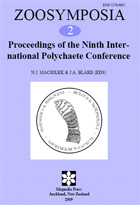Abstract
Sabellariid polychaetes, commonly known as honeycomb worms, are capable of forming large reef-like aggregations. One species, Idanthyrsus cretus, has recently been found in several localities during surveys of Las Perlas Archipelago, Pacific Panama. Large reefs of this species have not been recorded elsewhere in the Tropical Eastern Pacific. The reef distribution patterns were examined and mapped with the aid of Geographical Information Systems. Principal Component Analysis showed that the distribution of polychaete reefs in Las Perlas Archipelago and the reef building itself seem to be mainly dependent on depth, suitable substrate, and topography, the potential particle size for tube building, and wave exposure. Cluster analysis of Random Amplified Polymorphic DNA with Polymerase Chain Reaction molecular techniques demonstrated that the polychaete reefs in Las Perlas Archipelago may be derived from one population.

